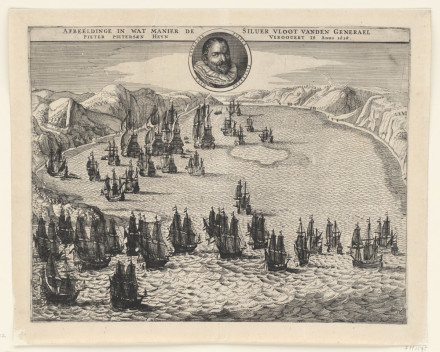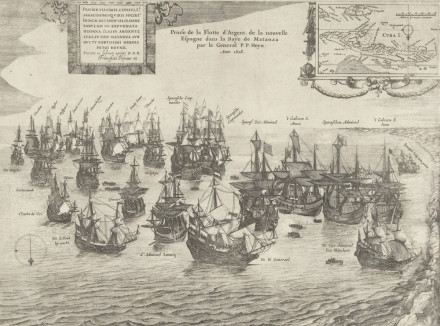History
We find information on the ship the Witte Leeuw ('White Lion') in the book Historie ofte Iaerlijck verhael... ('history or yearly tale') by Johannes de Laet, a director of the Dutch West India Company (WIC, see references). The Witte Leeuw formed part of the fleet of admiral Piet Hein that captured the Spanish treasure fleet in September 1628 near Matanzas de Cuba (De Laet V., p. 136). This was a major event in Dutch (maritime) history. The Witte Leeuw returned to the Netherlands with the majority of the fleet of Piet Hein.
The next year, another fleet left the Netherlands to the West Indies under admiral Adriaan Jansz. Pater. The squadron from Amsterdam, which sailed later then the main fleet, consisted of the ships Witte Leeuw, Dolfijn, Leiden, Drie Koningen and the yacht the Kat and left from the island of Texel on April 21st.
They arrived at Barbados on June 10th and sailed to Haiti from there. They could not find Pater there and sailed on to Cape San Antonio on the west coast of Cuba. From there, they continued past Cuba and towards the Cayman Islands. Upon their return to Cuba, they finally encountered admiral Pater on July 10th 1629. They were unsuccessful in attacking Spanish ships and towards the autumn it was decided that a part of the ships would winter in the Caribbean, of which the Witte Leeuw was one. Another part of the ships (that were in less good shape) returned to the Netherlands. In November, the squadron of the Witte Leeuw went towards Saint Vincent and beyond (De Laet VI p. 159-165).
A later reference to the Witte Leeuw reports that the ship was on Saint Vincent and that it had left there on 26 November 1629 together with the Walcheren. In January 1630 the Witte Leeuw visited a number of islands with a squadron in what is today called the Dominican Republic (De Laet VII, 118-119).

Description
WIC chamber: Amsterdam
Crew: 131 sailors, 44 soldiers
Tonnage: 250 last/500 tons
Armament: originally 2 bronze and 24 iron cannons; when she sailed for the second time 4 bronze and 26 iron cannons
In his book, De Laet makes a division between ships or big ships (between 130 and 250 last) and yachts like the Kat in this squadron that was 90 last (De Laet VI, p. 160).

Detail of the capture of the treasure fleet in Matanzas Bay by admiral Piet Hein, anonymous, 1628. Of many ships, the name is given, but that of the Witte Leeuw is not put in. This fleet had many ships with Leeuw ('Lion') in the name, there were the Witte, Rode, Zwarte and Gouden Leeuw (White, Black, Red, Golden...). This is possibly caused by the fact the many ships were named by the carvings on the stern.
| Master | Hoorn, Jan Jansz. van |
|---|---|
| People on board | 175 |
Status
The last reference to the ship in De Laet is from early 1630. It is assumed that the ship stayed in the West and perished or was demolished there at a certain time.
Possible slave voyages
According to Slavevoyages.org, a WIC ship with the name Witte Leeuw made at least one slave voyage. Of this voyage, accounts are also kept in the National Archives in the Hague.
1638: Gold Coast, Bight of Benin and Bight of Biafra to Pernambuco, of the 228 persons taken on board, 207 survived the voyage.
References
- De Laet, Joanis.
Historie ofte iaerlijck verhael van de verrichtinghen der geoctroyeerde West-Indische Compagnie, zedert haer begin, tot het eynde van 't jaer sesthien-hondert ses-en-dertich; begrepen. - slavevoyages.org.
Slave Voyages. - pp 33.
Nationaal archief, Den Haag.
WIC.
1.05.01.01/53.